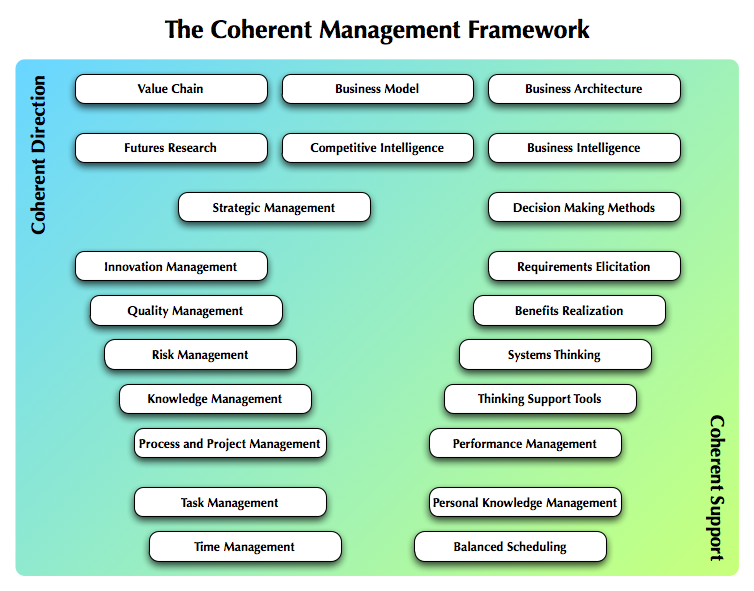The Coherent Management Framework (CMF), developed through practical experience across many industries, but at the same time built on a solid foundation of scientific research, got its name from its central purpose: Ensuring coherence across an organization's various activities.
On the one hand, this calls for a coherent direction of those activities. This direction should drive both organizational output and organizational development towards the organization's mission. However, it also has to be realistic in terms of the demands it places on people, processes, and systems.
On the other hand, in order to achieve maximum alignment to that direction and maximum performance in that direction, the support along the way also needs to be coherent. Certain methods are more suitable for this than others, and provide more synergies between them.

At the top of the CMF we find elements that define the general modus operandi of an organization (value chain, business model, business architecture) as well as inputs for its long term and short term direction (futures research, competitive intelligence, business intelligence), all drawn together by strategic management. Both strategy itself and its implementation benefit from advanced decision making methods.
Down the left hand side of the CMF we find important cross-functional disciplines (innovation management, quality management, risk management, knowledge management, process management, project management). On the operational level, while task management and time management often already do get a lot of attention, they are emphasized by the CMF because they are rarely handled in the coherent fashion required for maximum effect.
Down the right hand side of the CMF we find supporting elements. The success of requirements elicitation (which in its generalized form can be employed not just for marketing and product development, but for virtually all organizational activities) is ensured by benefits realization management. Systems thinking surfaces hidden assumptions as well as vicious and virtuous circles. Thinking support tools and modern performance management further enable effectiveness and efficiency. Personal knowledge management and balanced scheduling inform the "how" aspect of daily operations.
The positioning of the elements in the lower two thirds of the CMF is such that it highlights further synergies between elements at a similar vertical position down the left and down the right.
The CMF does not show typical business functions like production, marketing, sales, and after-sales support. The reason for this is simple: The framework applies across all of these, and indeed coherence can only be achieved if efforts are not confined to one specific function.
However, and that is part of the economic appeal of the framework, one can start either top-down from the corporate strategy level or bottom-up from any function. One can easily see a lot more implementation flexibility by looking at the CMF's elements and their arrangement, which also indicate different possible starting points.
The CMF is also aligned with the Coherent Business Model (CBM), which is useful both for assessment and for business model innovation, as well as with Coherent Dynamic Planning (CDP), a method for priority management paying special attention to connections (different kinds of dependencies and synergies) between activities.